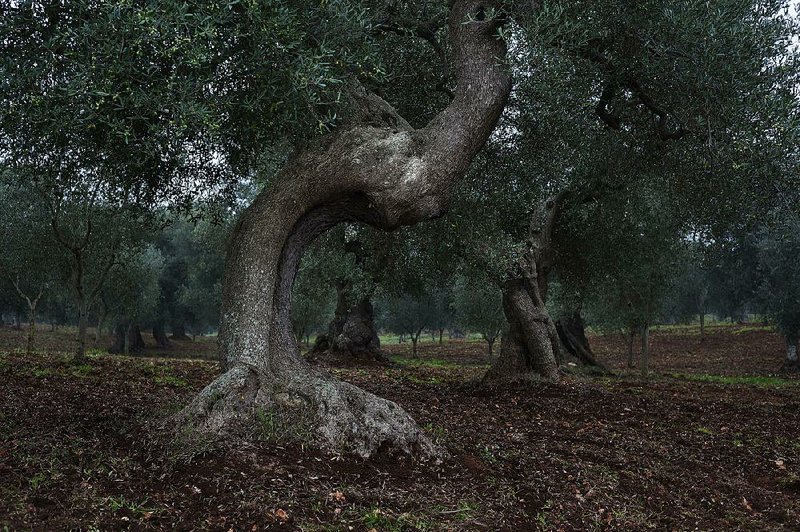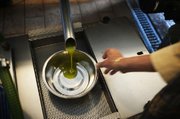The bottles were presenting a problem.
The stainless-steel one was best at keeping out the light, but it conducted heat and it wasn’t cheap. The painted glass bottle was promising, but only if it was made with the right paint. Dark glass was still an option, though not ideal.
“The wrong container can ruin all of our work,” said Nico Sartori, our host. It had been an emotional morning — and we hadn’t even gotten to the subject of corking.
I had been invited to Fattoria Altomena, an olive oil farm just outside of Florence, to meet six of the region’s most respected olive oil producers.
Every few months, these gentleman farmers — all of whom favor crisp, button-down shirts and elegantly trimmed facial hair — meet at one of their farms to discuss machinery, bottling, whatever is going on in their business.
“There is no competition; we all love olive oil,” said Francesco Biagiotti of Compagnia degli Oliandoli. “If the whole world used as much olive oil as we do, we would be very rich.”
Olive oil, they explained, is more than something to drizzle over a dish when you want to impress company. It is a lifestyle.
“A good wine lasts one dinner; a good oil lasts many meals,” said Michele Porcu of I Greppi di Silli. “Once you taste a high-quality oil, you can’t go back to the other kind. It will taste rancid, like chemicals.”
I was in Italy to get exactly this sort of education.
More than any time in recent memory, olive oil is an increasingly precious commodity. Last year’s harvest was severely damaged by extreme weather and a devastating fruit fly infestation. A few regions to the south, in Puglia, olive trees have suffered a catastrophic bacterial infection that has wiped out at least 1 million trees.
With all this in mind, I had come to the old country on a month-long quest to develop my American taste buds. People go on wine tours of Italy, why not an olive oil tour?
The itinerary was simple: Start in Tuscany, sampling olive oils from the world’s most famous producing region. Then head south to Puglia, the rugged, salty heel of Italy’s boot. Less famous, but far more prolific, Puglia is the olive oil capital of the country.
My friend John Voigtmann, who owns the boutique hotels La Bandita and La Bandita Townhouse in Pienza, had explained the difference between Italian olive oil provenances. “We’re at 500 meters above sea level here. Olive oil from this part of Tuscany is delicate, like a pinot noir. When you get to Puglia, the olive oil is like a big cabernet, it’s much heartier.”
Back in the tasting room, someone passed a small bottle of cloudy green oil. I poured a teaspoon’s worth into a glass and drank. It tasted like … olive oil. My schooling had a way to go.
Technically, extra-virgin olive oil can include no chemicals and must have an acidity level of less than 0.8 percent. Less technically, “when you taste the oil, you must smell leaves of tomato and wild artichoke,” said Filippo Alampi of Fattoria Ramerino. “That’s a good Tuscan oil.”
As I left, Sartori handed me an armful of bottles, all slightly chilled from storage. He looked me dead in the eye.
“Light. Heat. Air,” he said. “These are their natural enemies.”
THE ART OF TASTING
I arrived in Val d’Orcia just as the afternoon air was at its golden-hued best. I made my way down a dusty dirt road to Chiarentana, once part of the historic La Foce estate, to meet Donata Origo, the daughter of the English writer Iris Origo, who moved here from Florence with her husband in the 1920s. (La Foce, run by Origo’s sister, is next to Chiarentana.)
“People like the taste of their childhood,” said Origo, who has made olive oil at Chiarentana for seven years. “In Tuscany, olive oil has many different tastes, ranging from freshly cut grass, sage and artichoke to tomatoes and bananas. And pepper. A good Tuscan oil should scratch your throat slightly.”
Origo makes several different oils from five varietals (leccino, moraiolo, frantoiano, maurino and pendolino) and two blends, Chiarentana and Confini. I poured a thimbleful of oil from one of the steel vats and drank it. Wrong, wrong, wrong.
“To taste an oil, you must first smell it with one nostril, and then the other,” said Origo, explaining that one nostril is always stronger. “Now take a tiny sip and let it slide down your tongue.”
Then she sort of half-smiled, half-smirked, leaving her mouth slightly agape — and suddenly made a loud noise, half-sucking, half-gasping. For a moment, I thought she was choking. But this was her technique for bringing out the subtleties of the oil, and I was expected to do the same thing.
I made my way down the row of steel vats. Pour, smell, sip, gasp. As stupid as I felt, the technique really did work. There was the spicy tang of the moraiolo, the smooth grassiness of the leccino, the sweet bitterness of the Chiarentana.
Inside, I danced a little jig: That was the first moment I have ever tasted flavors in olive oil. Most surprisingly, the taste that lingered on my palate was not oil. This, it turned out, was a good thing.
“If your mouth feels oily, that is a bad sign,” Origo explained. “Olives must be picked and pressed immediately. The whole process, from tree to oil, should take no more than four to six hours. When it takes longer, oxidation is a risk. The quality can drop when you ship olive oil if care isn’t taken to maintain the proper temperature.”
As we drove south, the hillsides of Tuscany gave way to craggy mountains, then lush countryside, until finally, after hours in the car, we entered a low, flat plateau that ran along the coast of the Adriatic. Puglia is stark, beautiful, almost North African. The air is dry and salty; the earth is rough and stony and burned red with clay under an unforgiving blue sky. And everywhere, in every direction, at every turn: olive trees.
Puglia produces almost 40 percent of the olive oil in Italy. There are some 60 million olive trees here, and millions of them are so old they are protected by the government. With water on three sides, it’s the perfect place to bring in olive oil from outside Italy, process or bottle it in Puglia and pass off fake stuff for the real thing.
“The vast majority of what’s sold around the world as ‘extra-virgin olive oil’ isn’t extra-virgin at all,” said Tom Mueller, the author of Extra Virginity: The Sublime and Scandalous World of Olive Oil. “Real extra-virgin olive oil is fresh-squeezed fruit juice; after all, olives are stone fruits, like plums or cherries. The fake stuff is dead liquid industrial fat.”
“The Mediterranean Sea is full of boats stocked with chlorophyll,” said Armando Balestrazzi of Masseria Il Frantoio, a hotel and olive farm just outside Ostuni, in Puglia. “People see green oil and think it’s better, but of course the color has no bearing on the quality. You must be careful and educate yourself about these things. There is no sommelier for olive oil.”
If there was, though, his name would be Angelo Silibello. Silibello owns Cibus, a restaurant in the village of Ceglie Messapica. White stone walls, open-air archways, pergolas of vines — Cibus is the kind of place that is so authentic that you feel like the first foreigner to ever stumble upon it.
My hosts that afternoon were Silibello and Giuseppe Pannarale, who owns the nearby Pannarale olive oil farm. We sat at a table covered in a starched white tablecloth, a decorative centerpiece of bright green apples and two dozen bottles of Pugliese olive oil. We had work to do.
“You must try oil in a dark blue glass,” Pannarale said. “This is the only way you will not be persuaded by the color, which is irrelevant. You must hold the glass in your hands to warm it.”
Silibello took a crisp green apple from the centerpiece, which was not decoration after all, and sliced off a piece.
“This is the best way to clear the taste out of your mouth,” he said.
It was becoming clear that there are as many ways to taste oil as there are people who produce it. Paolo Rossi at Il Palagio had suggested trying olive oil on a slice of warm boiled potato. Donata Origo had her smell, sip, gasp method. Dania Masotti, of the revered Tuscan restaurant La Chiusa in Montefollonico, had maybe the most sensible advice: “Use a spoon. You don’t need anything else.”
A dozen olive oils later, drunk with polyphenols, I left Cibus and walked out into the blinding sunshine. I tried to remember what olive oil tasted like when it tasted like nothing more than olive oil, before I could detect different flavors, and I couldn’t do it. My schooling had been a success.
THE MAGIC OF OLIVE OIL
A few days before we were scheduled to go home, I had one last meeting, with the Pugliese version of that Tuscan round table where I started my education. Only this conclave of olive oil producers would not be in a tasting room. Instead, we met, appropriately, at Torre Guaceto.
The 5,000-acre wildlife preserve is populated with some of the oldest trees in all of Italy, so gnarled and twisted they looked as if they could unroot themselves and stumble away. I was meeting the heads of seven of the most reputable olive oil farms in the region. Imagine a team in which the uniform is hair gel, chunky watches and pastel linen shirts unbuttoned to the sternum. This is Team Puglia Olive Oil.
“In Puglia, you can find olive oil to match any food,” said Francesca Faccilongo of L’Agricola Paglione. “It’s like wine. You would never serve coratina oil with fish. Could you imagine?”
Actually, yes, I could. Maybe I wasn’t as well-versed as I thought. Next they were going to tell me that I couldn’t keep my olive oil next to the stove.
“It can’t be near the heat from the kitchen,” said Pietro Intini of Olio Intini. Where did he keep his? “In a cave, of course.” Of course.
After a month in Italy, I’d be leaving with an appreciation of this ancient oil, for the way tomato and wild artichokes and almonds can make their way into its aroma, for the importance of dark bottles, and I’d always know to raise an eyebrow at olive oil that’s a little too green.
“If it always tastes the same, that’s not how olive oil works,” Faccilongo said, as we walked back to our cars. “If it always tastes the same, you have missed all the magic of olive oil.”



